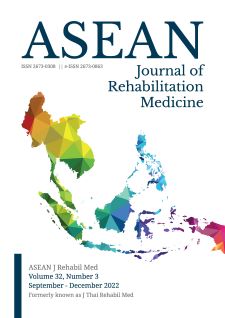The Feasibility of Vitamin B Complex Additive to Lidocaine for Myofascial Trigger Point Injection in Neck and Upper Back Muscles: A Pilot Trial
Keywords:
pain, myofascial pain syndrome, trigger point injection, lidocaine, vitamin B complexAbstract
Objectives: To explore the feasibility and result of adding the vitamin B complex to lidocaine for a myofascial trigger point (MTrP) injection in reducing pain and disability in patients with myofascial pain syndrome (MPS).
Study design: A pilot randomized double-blind controlled trial.
Setting: Thammasat University Hospital, Thailand.
Subjects: Thirty-eight patients aged between 18 to 70-year-old with active MTrP on neck and upper back and pain less than 6 months.
Methods: The patients were randomly assigned into two groups. The treatment group (n = 20, side = 33) were treated with 0.4 ml mixture of vitamin B complex and 1% lidocaine (1:1 ratio) whereas the control group (n = 18, side = 29) was treated with 0.2 ml of 1% lidocaine only. The patients and assessors were blinded to the treatments assigned. Numeric rating scale (NRS) for pain and neck disability index (NDI) were rated by the patients at baseline and at the end of week 1, 2 and 4. A linear mixed effect model was used.
Results: The NRS and NDI scores were significantly decreased at the end of week 1, 2 and 4 but no significant differences between the two groups (p-value = 0.802 and 0.072, respectively). Post-injection soreness was mostly found with significant difference between the two groups (p = 0.042).
Conclusions: Adding vitamin B complex to lidocaine for MTrP injection in neck and upper back muscles does not give better outcomes in pain and disability than injection with lidocaine alone. The feasibility and result of pilot study in term of design is useful, although vitamin B complex as an intervention should be reconsidered in preparation and adverse event.
References
Simons DG, Travell JG, Simons LS. Myofascial pain and dysfunction: the trigger point manual. Vol 1; upper half of body. 2nd ed. Baltimore: Williams & Wilkins; 1999. p. 1068.
Depeint F, Bruce WR, Shangari N, Mehta R, O’ Brien PJ. Mitochondrial function and toxicity: role of the B vitamin family on mitochondrial energy metabolism. Chem Biol Interact. 2006;163:94-112.
Laquale KM. B-Complex Vitamins’ Role in Energy Release. Athletic Therapy Today. 2006;11:70-3.
Gerald F C, James P M. The vitamins: fundamental aspects in nutrition and health. 5th ed. Amsterdam, Boston: Elsevier Academic Press; 2017. p. 612.
Prapanbandit N. Trigger point injection with 1% versus 2% lidocaine for treatment of myofascial pain syndrome at neck and upper back: a randomized controlled and double-blinded clinical trial. ASEAN Rehabil Med. 2019;29:99-106.
Kamanli A, Kaya A, Ardicoglu O, Ozgocmen S, Zengin FO, Bayik Y. Comparison of lidocaine injection, botulinum toxin injection, and dry needling to trigger points in myofascial pain syndrome. Rheumatol Int. 2005;25:604-11.
Kamolsawat N, Piravej K. A comparison of dry needling and 1% xylocaine injection to myofascial trigger point in neck and upper back pain. J Thai Rehabil. 2005;15:88-100.
Ga H, Choi J-H, Park C-H, Yoon H-J. Acupuncture needling versus lidocaine injection of trigger points in myofascial pain syndrome in elderly patients--a randomised trial. Acupunct Med. 2007;25:130-6.
Hong CZ. Lidocaine injection versus dry needling to myofascial trigger point. The importance of the local twitch response. Am J Phys Med Rehabil. 1994;73:256-63.
Raeissadat SA, Rayegani SM, Sadeghi F, Rahimi-Dehgolan S. Comparison of ozone and lidocaine injection efficacy vs dry needling in myofascial pain syndrome patients. J Pain Res. 2018;11: 1273-9.
Choi JW, Lee CJ, Lee SM, Shin BS, Jun B, Sim WS. Effect of hyaluronidase addition to lidocaine for trigger point injection in myofascial pain syndrome. Pain Practice. 2016;16:1019-26.
Magaña-Villa MC, Rocha-González HI, Fernández del Valle-Laisequilla C, Granados-Soto V, Rodríguez-Silverio J, Flores-Murrieta FJ, et al. B-vitamin mixture improves the analgesic effect of diclofenac in patients with osteoarthritis: a double blind study. Drug Res (Stuttg). 2013;63:289-92.
Pool JJM, Ostelo RWJG, Hoving JL, Bouter LM, de Vet HCW. Minimal clinically important change of the Neck Disability Index and the Numerical Rating Scale for patients with neck pain. Spine (Phila Pa 1976). 2007;32:3047-51.
Luksanapruksa P, Wathana-apisit T, Wanasinthop S, Sanpakit S, Chavasiri C. Reliability and validity study of a Thai version of the Neck Disability Index in patients with neck pain. J Med Assoc Thai. 2012;95:681-8.
Viechtbauer W, Smits L, Kotz D, Budé L, Spigt M, Serroyen J, et al. A simple formula for the calculation of sample size in pilot studies. J Clin Epidemiol. 2015;68:1375-9.
Genc H, Erdem R, Karaoglan B, Erturk C, Yorgancsoglu R. Effectivity of local anesthetic injection and dry needling in myofascial pain syndrome. J Rheum Med Rehabil. 1997;8:29-33.
Wong CSM, Wong SHS. A new look at trigger point injections. Anesthesiol Res Pract. 2012;2012:492452. doi: 10.1155/2012/492452.
Royer-Morrot MJ, Zhiri A, Paille F, Royer RJ. Plasma thiamine concentrations after intramuscular and oral multiple dosage regimens in healthy men. Eur J Clin Pharmacol. 1992;42:219-22.
Yoon SH, Rah UW, Sheen SS, Cho KH. Comparison of 3 needle sizes for trigger point injection in myofascial pain syndrome of upper- and middle-trapezius muscle: a randomized controlled trial. Arch Phys Med Rehabil. 2009;90:1332-9.
Finholt P, Higuchi T. Rate studies on the hydrolysis of niacinamide. J Pharm Sci. 1962;51:655-61.
Hopkins E, Sanvictores T, Sharma S. Physiology, Acid Base Balance [Internet]. StatPearls [Internet]. StatPearls Publishing; 2021. [cited 2022 Apr 28]. Available from: https://www.ncbi.nlm.nih.gov/books/NBK507807/.
Lei J, You HJ. Variation of pain and vasomotor responses evoked by intramuscular infusion of hypertonic saline in human subjects: influence of gender and its potential neural mechanisms. Brain Res Bull. 2012;87:564-70.
Downloads
Published
How to Cite
Issue
Section
License

This work is licensed under a Creative Commons Attribution-NonCommercial-NoDerivatives 4.0 International License.






